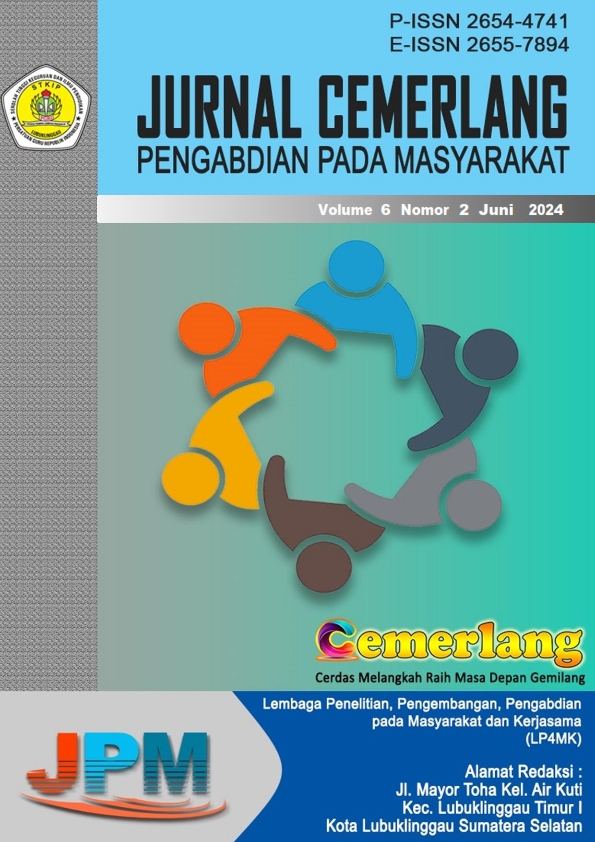Electric Motorbike Conversion Training to Reduce Pollution and Create A Friendly Environment For Society
Abstract
Electric motorbike conversion training at Vocational High Schools (SMK) and motorbike workshops in Kotabumi, North Lampung, is a strategic step to prepare future workers to face the electricity-based transportation revolution. This study aims to evaluate the impact of training on improving the technical skills of vocational school students and motorbike repair shop mechanics, as well as analyzing the contribution of training to the adoption of environmentally friendly technology at the local level. The training method includes theoretical exposure, field practice sessions, and case studies to provide an in-depth understanding of electric motor conversion. Evaluation is carried out through practical exams and collecting feedback from participants and instructors. The research results showed a significant increase in participants' knowledge and skills regarding electric motor conversion. Adoption of this technology in local motorbike workshops is also increasing, creating the potential for reduced environmental impact and generating positive effects on the local automotive industry. The conclusion confirms that this training was successful in empowering vocational school students and motorbike repair mechanics, creating new career opportunities, and stimulating economic growth in the region. However, challenges such as adapting infrastructure and changing mindsets were also identified as areas requiring further attention. Therefore, this research provides valuable insights for further development in supporting technical education, industrial innovation and sustainability at the local level.
References
Harahap, Partaonan. 2016. “Pengaruh Jatuh Tegangan Terhadap Kerja Motor Tiga Fasa Menggunakan Simulink MATLAB”. Media Elektrika. Vol.9, No. 2, (Hal 1-18), Desember 2016
Hernawati, D., & Amin, M. (2017). Analisis self efficacy mahasiswa melalui kemampuan presentasi di kelas. Education and Human Development Journal, 2(1), 26-33 https://doi.org/10.33086/ehdj.v2i1.379
Hirsh, R. F., & Koomey, J. G. (2016). Electricity Consumption and Economic Growth: A New Relationship with Significant Consequences? In Electricity Journal (Vol. 28, Issue 9, pp. 72–84). https://doi.org/10.1016/j.tej.2015.10.002
Muhsinin, S., Dinata, D. I., Andriansyah, I., & Asnawi, A. (2019). Peningkatan Potensi Ibu Rumah Tangga dalam Mengolah Sampah Organik Rumah Tangga Menggunakan Metode Takakura di Desa Cibiru Wetan, Kabupaten Bandung. Jurnal Pengabdian pada Masyarakat, 4(2), 179-186. https://doi.org/10.30653/002.201942.110
Permana, A., Yuningtyastuti, Y., & Sukmadi, T. (2016). Analisis Pengaruh Metode PengasutanMotor Induksi 3 Fasa Terhadap Kedip Tegangan Yang Terjadi Pada Jaringan Kelistrikan Pltgu Blok I Pt. Indonesia Power Up Semarang Menggunakan Simulasi Software ETAP12.6. 0.Transient: Jurnal Ilmiah Teknik Elektro,5(2), 134-141.
Pratama, gusti. (2021). Aplikasi Matlab Sebagai Simulasi Pengaturan Kecepatan Putaran Motor Induksi 3 Fasa Menggunakan VSD (Variable Speed Drive) Acs 800. Electro national conference (ENACO) politeknik negeri sriwijaya, , 42-48.
Ranjbar, Amir Hossein, Anahita Banei, Amir Khoobroo, B. F. (2017). Online Estimation of State of Charge in Li-Ion Batteries Using Impulse Response Concept | IEEE Journals & Magazine | IEEE Xplore. https://ieeexplore.ieee.org/abstract/document/6108373
Srinivas Mutyala, M. T. (2019). (n.d.). Design And Development Of Electric Motorbike. International Research Journal of Engineering and Technology (IRJET). Yantoro, W. D. (2019). Analisis Efisiensi Penggunaan Baterai Lithium Polymer 48 V 25 Ah Pada Sepeda Motor Listrik Yang Di Rancang Bangun Dengan Daya 3 Kw. Skripsi. http://repositori.usu.ac.id/handle/123456789/15962
Yandri, V. R. (2016). Studi Kelayakan Peralatan Pada Instalasi Panel Kontrol Di Bengkel Teknik Listrik, Politeknik Negeri Padang.Jurnal Teknik Elektro,5(1), 1-8.
Zainol, Z., Toha, S. F., Kamisan, N. A., & Bukhari, W. M. S. W. (2019). Design and development of a retrofit electric motorbike. International Journal of Recent Technology and Engineering, 7(6), 71–75.

Jurnal Pengabdian Masyarakat by http://ojs.stkippgri-lubuklinggau.ac.id/index.php/JPM is licensed under a Creative Commons Attribution-ShareAlike 4.0 International License.













